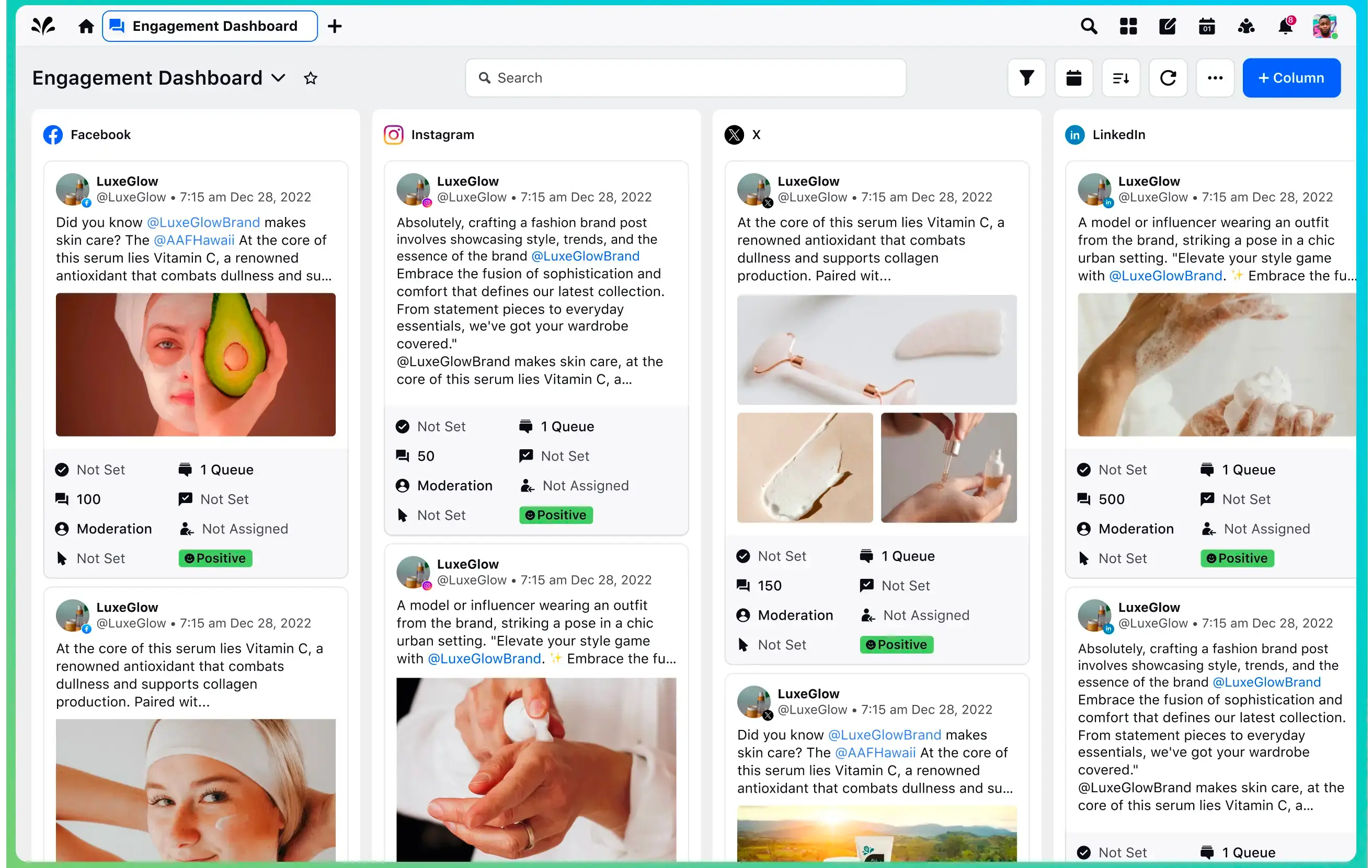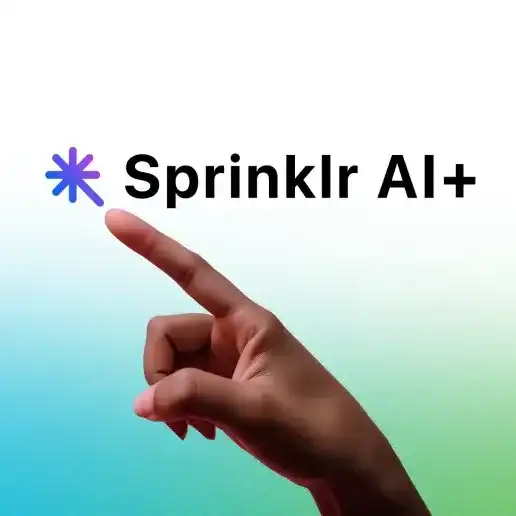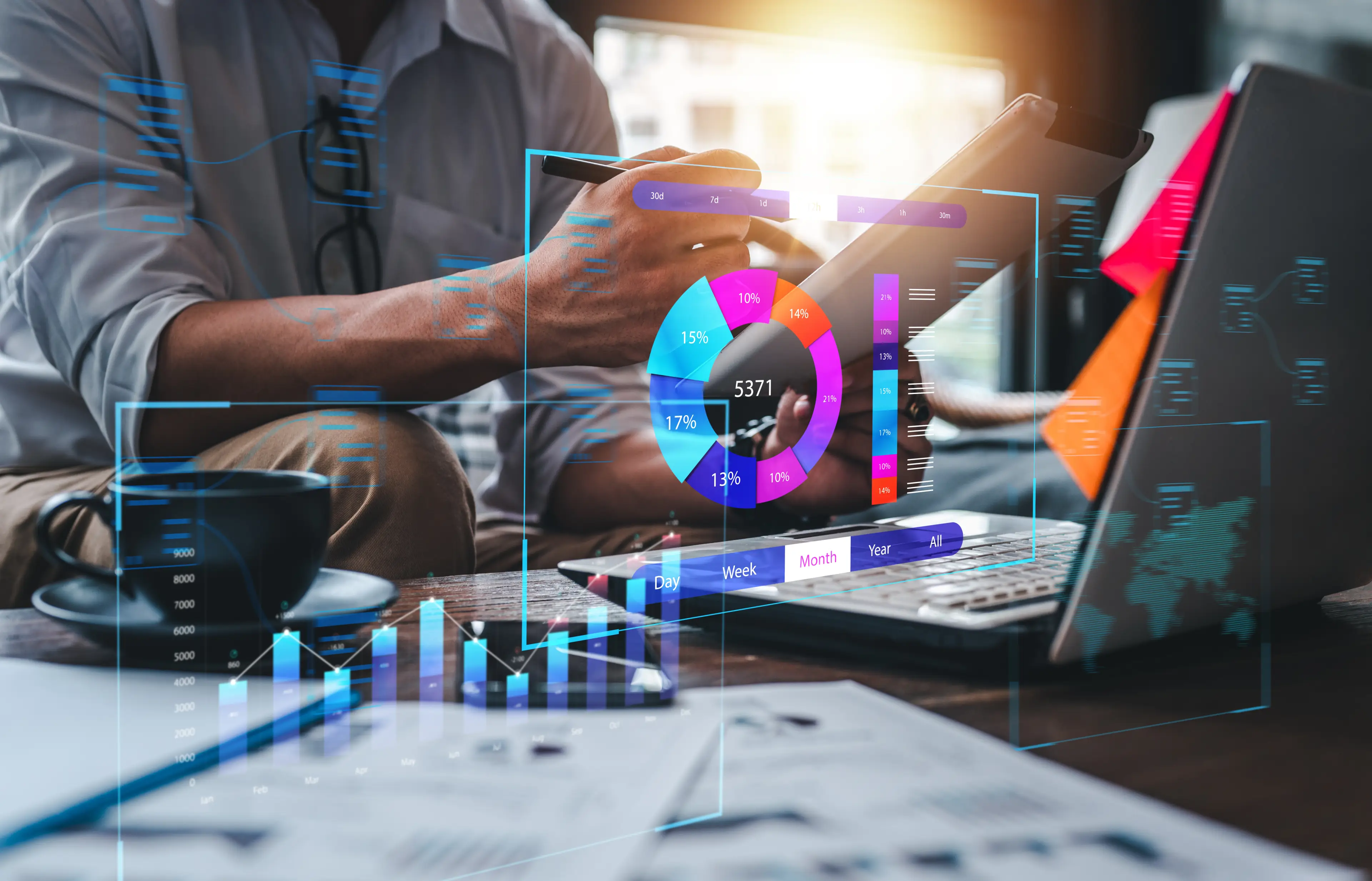The undisputed leader in social media management
For over a decade, the world’s largest enterprises have trusted Sprinklr Social for its in-depth listening, unmatched channel coverage, enterprise-grade configurability and industry-defining AI.

Social Media Business Intelligence: How to Use It
Today, if you were to tweet, “Hey @XYZ_Bank, I noticed an unrecognized charge on my statement. Can you provide more info?” the bank’s social media team will promptly come to the rescue. What a relief!
However, social media transcends mere communication; it serves as a crucial source of business intelligence.
For instance, watching social media interactions can provide the bank with insights. Like, what are the areas where its mobile app requires improvement?
But there’s a catch.
Tapping into the power of social media business intelligence (SMBI) has its own set of challenges.
Social media is like a bustling train station during rush hour. Information comes and goes at lightning speed, with people hopping on and off trains (read: posts) in a constant whirlwind.
With such speed and data overload comes the flip side: customer sentiment and brand perception can change in the blink of an eye.
So, if you want to get the most out of SMBI, you've got to be quick on the draw — grabbing actionable insights and knowing what to do with them ASAP.
Let’s start with the basics and then progress to learning how social intelligence can benefit your business.
What is social media business intelligence (SMBI)?
Social business intelligence is the process of creating reports and building dashboards by gathering social media insights.
It provides your teams with a deep understanding of how effectively your marketing is working and what people are discussing online. Simultaneously, it empowers your teams beyond the realm of marketing to make data-backed business decisions.
Now, SMBI involves advanced computing and modeling, which may lead you to think that data scientists are necessary.
However, numerous AI-powered social media analytics tools provide user-friendly analytics that you can seamlessly integrate into your reporting and strategy workflow.
How about we explore some use cases?
5 social media intelligence use cases in marketing and business
The crucial factor that sets SMBI apart from raw data is how you apply it. Join me in understanding how.
Use case #1: Uncover customer sentiment
What's the overall sentiment your customers have about your brand — positive, negative or neutral? Has their view shifted over time, and if it has, when and why did that happen?
Sentiment analysis empowers you to comprehend how your business and its offerings are perceived by both current and potential customers.
These tools also assist you in recognizing patterns and determining the specific days and times when significant changes occur.
How to use customer sentiment insights:
- Pinpoint out which actions really impact how customers feel
- Do more of the things that make customers happy
- Be proactive in addressing issues that might lead to unhappy customers
Nip negative sentiments and PR crises in the bud by leveraging AI
Keeping an ear to the customer's voice lets you hear exactly what your brand needs to know. An advanced social listening tool helps you dig through billions of data points across all your social channels like a super-sleuth.
It indicates impending crises before time so your teams can kick into action mitigating risks. This tool is your early warning system — think of it as your brand’s own MI6 agent, always on the lookout.

Stay on top of your game on 30+ digital and social channels, providing you with absolute coverage of your entire digital reach and efficient crisis handling. Give it a try for free!
Use case #2: Perform market research
Is your company thinking about introducing an up-and-coming product or service? Are you looking to broaden your presence in a different region or market?
Social media monitoring allows you to keep an eye on what people find interesting about your business offerings. You can also follow conversations about your industry and gauge people's awareness of the solutions available for their issues.
How to use these market research insights:
- Make more informed decisions about expanding into new markets
- Strategize new products and services launches
- Formulate pricing strategies while considering factors such as production costs, competitor pricing and perceived value by customers
Use case #3: Measure campaign success
Did the latest campaign create the buzz you were aiming for? Is it a good idea to continue with your current social media marketing campaign?
SMBI tools simplify the measurement of individual campaign success. You can track how people responded to your efforts and figure out if the campaigns turned the tide.
How to use campaign success insights:
- Determine the combination of elements (CTA, timing, frequency, influencer collaboration, etc.) that your brand requires to make a marketing campaign successful and then create social media campaigns that are more impactful
- Organize products/offerings mix in a more strategic manner — identifying high-performing products, slow movers and gaps
Supercharge campaign ideation with AI
Keeping up with the latest trends and crafting killer campaigns can feel like playing a high-stakes game, right? Well, good news — you're living in the golden age of generative AI!
What if AI could turbocharge your brainstorming sessions and keep you ahead of the curve with sophisticated campaign strategies? It can swiftly generate the gripping campaign ideas for you in no time, so you're always playing to win.
For example, this is how it looks for a healthcare brand. 👇

But want to see how it can look for yours? How can genAI energize your marketing like espresso fuels an all-night coder? Book a demo with us today.
Use case #4: Evaluate your sales funnels
Are your sales funnels effectively guiding potential customers through their journey? Do you observe certain strategies yielding better results than others?
With social media business intelligence, you can keep tabs on the channels that bring in the best results for your business. Whether it's engagement, clicks or conversions, you get a clear picture of how each channel adds to your overall progress
How to use sales insights:
- Make data-driven improvements to your sales funnel
- Develop more effective content tailored for each stage of the sales funnel — allowing you to make the most of your marketing budget
Read More: How to Create Social Media Marketing Funnel in Just 7 Steps
Use case #5: Benchmark against your competitors
How does your brand stack up against your main competitor in terms of share of voice? Overall, do people tend to view other brands in your industry more positively or negatively?
Social media business intelligence opens up the possibility to actively track not only your own brand but also dive into discussions about your competitors. These insights enable you to explore customer sentiments, identify pain points and assess the success of marketing campaigns in the conversations around rival brands.
How to use competitive benchmarking insights:
- Inform your organization’s marketing strategy and campaigns
- Better position your brand, products and services
Read More: What is Competitive Benchmarking?
Key metrics in social media business intelligence
By now we’ve covered how social media business intelligence is about learning more about social media performance and using data and analytics to make better decisions.
In that light, here are the key metrics that play a crucial role in assessing the effectiveness of social media strategies.
Engagement metrics
Likes/reactions: Denotes the number of users who appreciated the content.
Comments: Reflects the level of interaction and conversation around the content.
Shares/retweets: Shows the content's virality and reach within the network.
Reach and impressions
Reach: The total number of unique users who see a piece of content.
Impressions: The total number of times a piece of content is displayed, including multiple views by the same user.
Read More: Social media Reach vs. Impressions: What's the difference?
Follower growth
New followers: Measures the number of new followers gained over a specific period.
Follower churn: The number of followers lost over a specific period.
Click-through rate (CTR)
Link clicks: Measures the number of clicks on links shared in posts.
CTR: The percentage of users who clicked on a link out of the total who saw the post.
Conversion metrics
Conversion rate: Quantifies the percentage of users who took a desired action (e.g., making a purchase) after clicking on a link.
Conversion tracking: Monitors specific actions or events (e.g., form submissions) triggered by social media interactions.
Sentiment analysis
Positive/negative sentiment: Analyzes user comments and mentions to gauge overall sentiment.
Sentiment trends: Tracks changes in sentiment over time.
Customer support metrics
Response time: Measures how quickly the brand responds to customer inquiries or mentions.
Resolution time: Measures the time it takes to resolve customer issues.
Content performance
Top performing content: Identifies the most engaging and effective content types.
Content reach: Measures the audience reached by different types of content.
Brand mentions
Volume of mentions: Tracks how often the brand is mentioned across social media platforms.
Top mention sources: The most influential sources mentioning the brand.
Social media ROI
Cost per click (CPC): Measures the cost of each click on a paid social media campaign.
Return on ad spend (ROAS): Calculates the revenue generated compared to the cost of advertising.
Audience demographics
Age, gender, location: The demographics of the social media audience.
Audience growth: Tracks changes in the size and composition of the audience.
Monitoring these key metrics provides valuable insights into the performance of social media strategies and helps optimize future efforts to achieve business goals.
Make sense of the flood of data from your social channels with insider tips on metrics that truly matter.
Learn
- Which metrics to watch
- Why they're crucial
- How to turn them into actionable strategies that push your marketing forward.
If you’re ready to stop guessing and start targeting your efforts for maximum impact, this e-book👇 is your next must-read. And for free!
Examples of social media business intelligence reports
Social media business intelligence reports take data from various social media management platforms and break it down in a way that you can easily understand.
The content of these reports can differ a lot. It really depends on what a business is aiming for and which social media platforms they're looking into.
Some typical examples include:
Audience analysis report
This report focuses on the demographics, interests and behavior of a business's social media audience. It may include data like age range, gender breakdown, geographic distribution, peak activity times and common interests or hobbies.
Don’t Miss: Your Complete Guide to Audience Targeting
Brand mention analysis report
This report tracks how often and in what context a brand is mentioned across social media. It can provide insights into brand sentiment, reach and the effectiveness of marketing campaigns.
Competitor analysis report
This compares a business's social media performance to that of its competitors. It might include metrics like follower count, engagement rates, content strategy and response times.
Content performance report
Analyzes which types of posts (images, videos, text) are performing best in terms of engagement (likes, shares, comments) and reach. This report helps in understanding what content resonates most with the audience.
💡 Quick Tip: Use AI to assess your content from multiple channels to get unified reporting onto one space. With Sprinklr’s Content Marketing solution, you can do this across 30+ channels to gauge what’s working. Integrate, compare and contrast data from various streams — think social buzz, web analytics and third-party tools. Set unique benchmarks, align with your business objectives and turn content performance data into actionable strategies. Want to see how your team can make the most out of its content?
Customer service analysis report
Evaluates how effectively a business is using social media for customer service. Metrics might include response time, resolution rate and customer satisfaction.
Check Out: Customer Service Reports: A Complete Guide for Managers
Influencer engagement report
If a business collaborates with influencers, this report tracks the performance of these partnerships. Metrics could include reach, engagement and conversion rates from influencer-led campaigns.
Level Up: Influencer Marketing Strategies to Improve Engagement
Trend analysis report
This report looks at broader trends in the social media landscape. It might cover emerging hashtags, popular content formats or shifts in user behavior.
Read More: How to Use Trend Analysis to Maximize Social Listening
Sentiment analysis report
Uses natural language processing to gauge the overall sentiment (positive, negative, neutral) of social media mentions related to a business or its products.
Also Read: Social Media Sentiment Analysis: An Easy Guide
Ad performance report
For businesses running paid social media campaigns, this report provides data on the effectiveness of these ads. Metrics might include click-through rates, conversion rates and return on ad spend.
💡 Did you know? If you centralize your multichannel social advertising, you can boost your ROAS by 50%?
This is possible when you use a central hub to seamlessly plan, execute, and optimize your social media ad campaigns. Advanced social advertising platforms empower your team with AI-driven insights to optimize your budgeting, bidding strategies and ad rotation, ensuring that every decision is data-backed and effective. Want to know how you can manage your paid, owned, and earned media effortlessly? Let’s journey together.
ROI analysis report
Aimed at calculating the return on investment for social media activities, combining various metrics like customer acquisition cost, conversion rates and overall revenue generated through social media channels.
These reports usually have charts and graphs, along with written analysis, to help you use the data for business decisions. You can tailor them to your business's unique needs and the social media sites you use most, like TikTok, Facebook, Instagram, Twitter or LinkedIn.
Did you know 83% of consumers love to shop during messaging conversations?
Use AI to turn every chat into a chance to charm and sell. Our latest whitepaper delves into the start to finish strategy. Discover how to merge AI with human touch to make every chat a potential checkout. Boost your ROI by setting journey goals that cater to loyal fans and reel in fresh faces to your brand💲.
Tips to implement BI in your social media strategy
When you bring business intelligence into your social media game, you get a clearer picture of what your customers are up to, what's trending in the market, and how well your campaigns are doing.
So, here's the deal on how to smoothly mix business intelligence into building an ideal social media strategy:
Leverage data analytics tools
Utilize an advanced social media management tool like Sprinklr Social that can process large volumes of data from your social media channels. These tools can provide insights into user engagement, demographic information, content performance and more. Look for features like sentiment analysis, trend forecasting and competitor analysis.
Why? By analyzing this data, you can make informed decisions about your social media strategy, such as what content resonates with your audience, the best times to post on social media and which platforms yield the highest engagement.
Set clear objectives and key performance indicators (KPIs)
Before diving into data analysis, it’s crucial to define what success looks like for your social media campaigns. Set clear objectives and identify relevant social media KPIs that align with your business goals. These could include metrics like engagement rate, click-through rate, conversion rate or follower growth.
Why? Tracking these KPIs will help you understand how well your social media activities are contributing to your business objectives and where you need to make adjustments.
Interesting Read: Your A-to-Z on Social Media Goal Setting
Integrate social media data with other business data
To get a comprehensive view of your business performance, integrate social media data with other business data sources such as sales, customer service or website analytics.
You can go for Unified-CXM powered by AI. It pulls in petabytes of structured and unstructured data from customers — across different platforms, markets and languages.
Then it actively interprets it all, finding needles in haystacks to ensure that your business can recognize and understand every signal of customer intent.
Why? This holistic approach allows you to see how your social media efforts are impacting other areas of your business. For example, you can track how social media campaigns influence website traffic, lead generation or customer retention. This integration can provide deeper insights and help in making more strategic business decisions.
Keep in mind, nailing business intelligence in your social media is like being a social media ninja. You're always checking out what the data tells you and tweaking your moves to stay in sync with the ever-changing market and what your audience digs.
Signing off
As mentioned earlier, social media is like a bustling train station during rush hour. So, in the constant whirlwind of social media, tapping into business intelligence isn't just smart; it's essential.
We've unravelled the what, why and how of Social Media Business Intelligence. We also dived into its transformative use-cases, key metrics and examples.
Embrace our three golden tips and turn those insights into action. The future's bright, and with SMBI, you're not just participating, you're leading the parade.
Finally, Sprinklr AI+ can be your friend on this journey if you let it.
With the power of generative AI, it teams up with Sprinklr's advanced suite of products for stellar customer experiences. Currently fueled by Sprinklr AI, Open AI's GPT models and Google Cloud’s Vertex AI, it's the dream team of AI tech.
You can get to experience Sprinklr AI+ first-hand!




